面向对象实验五答案
- 格式:doc
- 大小:37.00 KB
- 文档页数:3
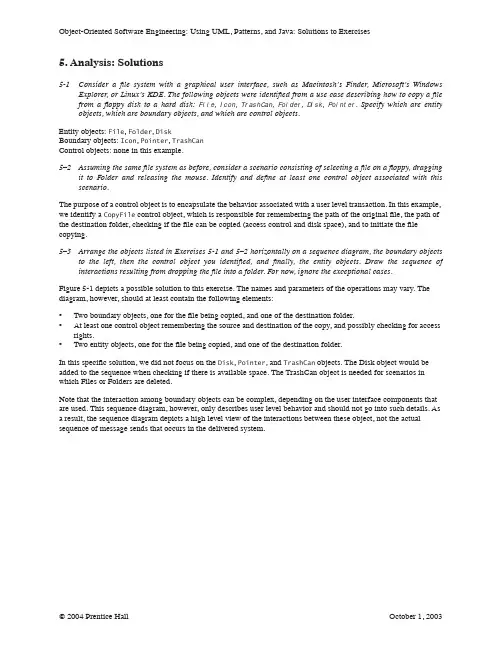
Object-Oriented Software Engineering: Using UML, Patterns, and Java: Solutions to Exercises5. Analysis: Solutions5-1Consider a file system with a graphical user interface, such as Macintosh’s Finder, Microsoft’s Windows Explorer, or Linux’s KDE. The following objects were identified from a use case describing how to copy a file from a floppy disk to a hard disk: File, Icon, TrashCan, Folder, Disk, Pointer. Specify which are entity objects, which are boundary objects, and which are control objects.Entity objects: File, Folder, DiskBoundary objects: Icon, Pointer, TrashCanControl objects: none in this example.5–2Assuming the same file system as before, consider a scenario consisting of selecting a file on a floppy, dragging it to Folder and releasing the mouse. Identify and define at least one control object associated with this scenario.The purpose of a control object is to encapsulate the behavior associated with a user level transaction. In this example, we identify a CopyFile control object, which is responsible for remembering the path of the original file, the path of the destination folder, checking if the file can be copied (access control and disk space), and to initiate the file copying.5–3Arrange the objects listed in Exercises 5-1 and 5–2 horizontally on a sequence diagram, the boundary objects to the left, then the control object you identified, and finally, the entity objects. Draw the sequence of interactions resulting from dropping the file into a folder. For now, ignore the exceptional cases.Figure 5-1 depicts a possible solution to this exercise. The names and parameters of the operations may vary. The diagram, however, should at least contain the following elements:•Two boundary objects, one for the file being copied, and one of the destination folder.•At least one control object remembering the source and destination of the copy, and possibly checking for access rights.•Two entity objects, one for the file being copied, and one of the destination folder.In this specific solution, we did not focus on the Disk, Pointer, and TrashCan objects. The Disk object would be added to the sequence when checking if there is available space. The TrashCan object is needed for scenarios in which Files or Folders are deleted.Note that the interaction among boundary objects can be complex, depending on the user interface components that are used. This sequence diagram, however, only describes user level behavior and should not go into such details. As a result, the sequence diagram depicts a high level view of the interactions between these object, not the actual sequence of message sends that occurs in the delivered system.Object-Oriented Software Engineering: Using UML, Patterns, and Java: Solutions to ExercisesFigure 5-2Sample solution for Exercise 5–45–5Identify the attributes of each object that are relevant to this scenario (copying a file from a floppy disk to a hard disk). Also consider the exception cases “There is already a file with that name in the folder” and “There is no more space on disk.”Object-Oriented Software Engineering: Using UML, Patterns, and Java: Solutions to ExercisesThe scenario implies that icons have positions (since they can be moved) and that they can be selected. Each Item, Folder or File, has a size attribute that is checked against the available space in the Disk. The exception “There is already a file with that name in the folder” implies that Item names are unique within a Folder. We represent this by adding a qualifier on the relationship between Item and Folder. Finally, when copying a file, we need to copy its contents, hence we add a contents attribute on the File object.Figure 5-4 A naive model of the Gregorian calendar (UML class diagram).5–7Consider the object model of Figure 5-32 in the book. Using association multiplicity only, can you modify the model such that a developer unfamiliar with the Gregorian calendar could deduce the number of days in each month? Identify additional classes if necessary.The purpose of this exercise is to show the limitation of association multiplicities. There is no complete solution tothis problem. A partial solution indicating the number of days in each month is depicted in Figure 5-5. We createdfour abstract classes for each of the possible month lengths, 11 classes for each of the nonvariable months and twoclasses for the month of February. The part that cannot be resolved with association multiplicities is the definition ofa leap year and that the number of days in February depends on whether the year is leap or not. In practice, thisObject-Oriented Software Engineering: Using UML, Patterns, and Java: Solutions to Exercisesproblem can solved by using informal or OCL constraints, described in more detail in Chapter 9, Object Design: Specifying Interfaces.Figure 5-5Revised class diagram indicating how many days each month includes.5–8Consider a traffic light system at a four-way crossroads (e.g., two roads intersecting at right angles). Assume the simplest algorithm for cycling through the lights (e.g., all traffic on one road is allowed to go through the crossroad while the other traffic is stopped). Identify the states of this system and draw a statechart describing them. Remember that each individual traffic light has three states (i.e. green, yellow, and red).Object-Oriented Software Engineering: Using UML, Patterns, and Java: Solutions to ExercisesWe model this system as two groups of lights, one for each road. Opposing lights have always the same value. Lights from at least one group must always be red for safety reasons. We assume there are no separate lights for left and right turns and that cycles are fixed. Figure 5-6 depicts the startchart diagram for this solution.5–10Consider the addition of a nonfunctional requirement stipulating that the effort needed by Advertisers toobtain exclusive sponsorships should be minimized. Change the AnnounceTournament and the ManageAdvertisement use cases (solution of Exercise 4-12) so that the Advertiser can specify preferences in her pro file so that exclusive sponsorships can be decided automatically by the system.Figure 5-7Sample solution for Exercise 5–5Object-Oriented Software Engineering: Using UML, Patterns, and Java: Solutions to ExercisesA new use case, ManageSponsorships , should be written and included in the ManageAdvertisement use case and de fine the preferences that the Advertiser can specify for automatically accepting an exclusive sponsorship. Figure 5-8 depicts a possible solution for this use case.In the AnnounceTournament use case, steps 6 & 7 are the modi fied as follows:6.The system noti fies the selected sponsors about the upcoming tournament and the flat fee for exclusive sponsorships. For advertisers who selected an automatic sponsorship preferences, the system automatically generates a positive answer if the fee falls within the bounds speci fied by the Advertiser.7.The system communicates their answers to the LeagueOwner .5–11Identify and write de finitions for any additional entity, boundary, and control objects participating in theAnnounceTournament use case that were introduced by realizing the change speci fied in Exercise 5-10.As speci fied above, this exercise should result in the identi fication of two new entity objects:•SponsorshipPreferences stores the time frame during which a tournament can be considered for an automatic sponsor ship and the maximum fee the Advertiser is willing to pay without being noti fied. This object also has associations to the leagues that should be considered during the automatic sponsorship decision.• ExclusiveSponsorship represents an exclusive sponsorship that was awarded to an Advertiser . It is associatedwith the tournament and Advertiser objects involved in the sponsorship. It stores a boolean indicating whether or not the sponsorship was decided automatically.However, the instructor may choose to extend the exercise so that the students also consider the objects participating in the ManageSponsorships use case. In this case, the student should identify a control object for the new use case and two boundary objects for displaying the exclusive sponsorships and the preferences, respectively.5–12Update the class diagrams of Figure 5-29 and Figure 5-31 to include the new objects you identi fied in Exercise5-11.Use case nameManageSponsorships Participating actorsInitiated by Advertiser Flow of events 1.The Advertiser requests the sponsorships area..2. ARENA displays the list of tournaments for which the Advertiserhas exclusive sponsorships and indicates for each tournamentwhether the exclusive sponsorship was decided by the system orthe Advertiser .3.The Advertiser may change the conditions under which atournament becomes a candidate for her exclusive sponsorship,including specifying a set of leagues, a time frame, or a maximumfee that she is willing to pay for an exclusive sponsorship. TheAdvertiser may also select not to use the automatic sponsorshipfeature and be noti fied about such opportunities directly.4.ARENA records the changes of preferences for the automatic sponsorships. Entry condition•The Advertiseris logged into ARENA .Exit conditions •ARENA checks the advertisers automatic sponsorship pro file for any new tournaments created after thecompletion of this use case.Figure 5-8ManageSponsorships use case.Figure 5-9 depicts the objects discussed in Exercise 5-11 and their associations.5–13The Figure 5-1 A UML startchart diagram for AnnounceTournamentControl .Create TournamentWait For Sponsor RepliesDecide on SponsorshipWait for Player Applicationsnotify sponsorship deadline expired notify players Decide on Interest Groupssponsors notify sponsors。
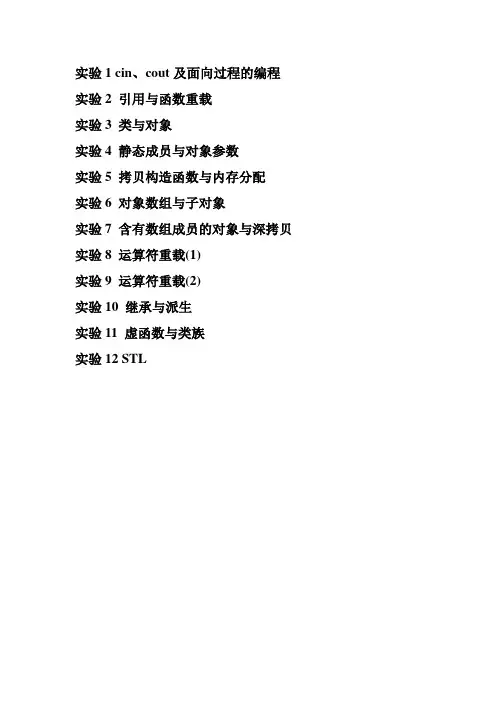
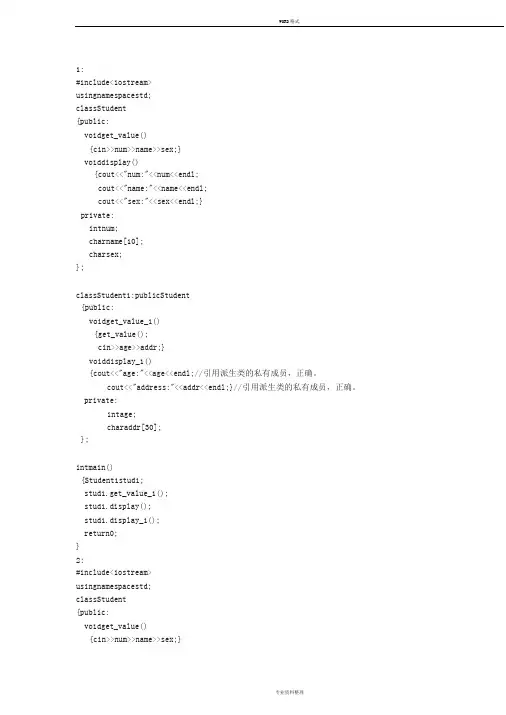
1:#include<iostream>usingnamespacestd;classStudent{public:voidget_value(){cin>>num>>name>>sex;}voiddisplay(){cout<<"num:"<<num<<endl;cout<<"name:"<<name<<endl;cout<<"sex:"<<sex<<endl;}private:intnum;charname[10];charsex;};classStudent1:publicStudent{public:voidget_value_1(){get_value();cin>>age>>addr;}voiddisplay_1(){cout<<"age:"<<age<<endl;//引用派生类的私有成员,正确。
cout<<"address:"<<addr<<endl;}//引用派生类的私有成员,正确。
private:intage;charaddr[30];};intmain(){Student1stud1;stud1.get_value_1();stud1.display();stud1.display_1();return0;}2:#include<iostream>usingnamespacestd;classStudent{public:voidget_value(){cin>>num>>name>>sex;}voiddisplay(){cout<<"num:"<<num<<endl;cout<<"name:"<<name<<endl;cout<<"sex:"<<sex<<endl;}private:intnum;charname[10];charsex;};classStudent1:privateStudent{public:voidget_value_1(){get_value();cin>>age>>addr;}voiddisplay_1(){display();cout<<"age:"<<age<<endl;//引用派生类的私有成员,正确。
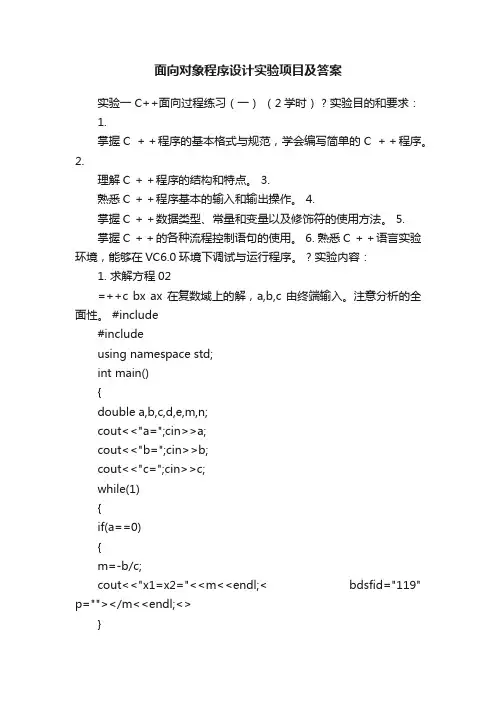
面向对象程序设计实验项目及答案实验一 C++面向过程练习(一)(2学时) ? 实验目的和要求:1.掌握C ++程序的基本格式与规范,学会编写简单的C ++程序。
2.理解C ++程序的结构和特点。
3.熟悉C ++程序基本的输入和输出操作。
4.掌握C ++数据类型、常量和变量以及修饰符的使用方法。
5.掌握C ++的各种流程控制语句的使用。
6. 熟悉C ++语言实验环境,能够在VC6.0环境下调试与运行程序。
? 实验内容:1. 求解方程02=++c bx ax 在复数域上的解,a,b,c 由终端输入。
注意分析的全面性。
#include#includeusing namespace std;int main(){double a,b,c,d,e,m,n;cout<<"a=";cin>>a;cout<<"b=";cin>>b;cout<<"c=";cin>>c;while(1){if(a==0){m=-b/c;cout<<"x1=x2="<<m<<endl;< bdsfid="119" p=""></m<<endl;<>}else{d=b*b-4*a*c;if(d>=0){e=sqrt(d);m=(-b+e)/(2*a);n=(-b-e)/(2*a);if(m!=n)cout<<"x1="<<m<<endl<<"x2="<<n<<endl;<bdsfid="131" p=""></m<<endl<<"x2="<<n<<endl;<> elsecout<<"x1=x2="<<m<<endl;< bdsfid="134" p=""></m<<endl;<>}else{e=sqrt(-d);m=-b/(2*a);n=e/(2*a);cout<<"x1="<<m<<"+"<<n<<"i"<<endl;< bdsfid="143" p=""></m<<"+"<<n<<"i"<<endl;<>cout<<"x2="<<m<<"-"<<n<<"i"<<endl;< bdsfid="145" p=""></m<<"-"<<n<<"i"<<endl;<>}}cout<<"a=";cin>>a;cout<<"b=";cin>>b;cout<<"c=";cin>>c;}return 0; }2. 猴子吃桃子问题:一天一只小猴子摘下一堆桃子,当即吃掉一半,还觉得不过瘾,又多吃了一个。
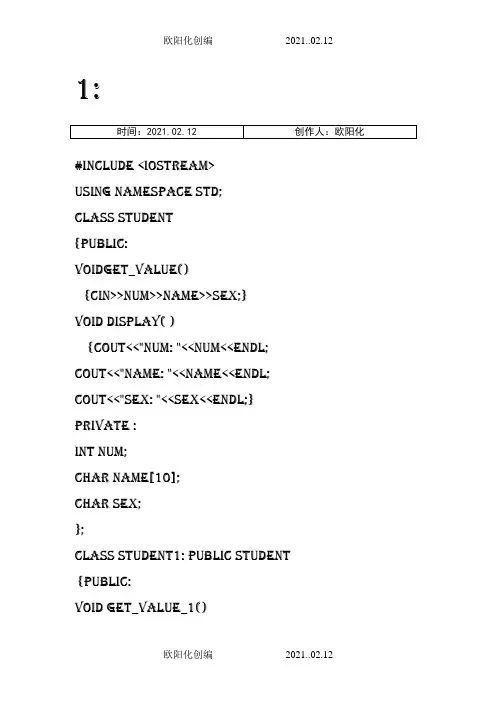
1:#include <iostream>using namespace std;class Student{public:voidget_value(){cin>>num>>name>>sex;}void display( ){cout<<"num: "<<num<<endl; cout<<"name: "<<name<<endl; cout<<"sex: "<<sex<<endl;} private :int num;char name[10];char sex;};class Student1: public Student {public:void get_value_1(){get_value();cin>>age>>addr;}void display_1(){ cout<<"age: "<<age<<endl; //引用派生类的私有成员,正确。
cout<<"address: "<<addr<<endl;} //引用派生类的私有成员,正确。
private:int age;charaddr[30];};int main(){Student1 stud1;stud1.get_value_1();stud1.display();stud1.display_1();return 0;}2:#include <iostream>using namespace std;class Student{public:voidget_value(){cin>>num>>name>>sex;}void display( ){cout<<"num: "<<num<<endl;cout<<"name: "<<name<<endl;cout<<"sex: "<<sex<<endl;}private :int num;char name[10];char sex;};class Student1: private Student{public:void get_value_1(){get_value();cin>>age>>addr;}void display_1(){display();cout<<"age: "<<age<<endl; //引用派生类的私有成员,正确。
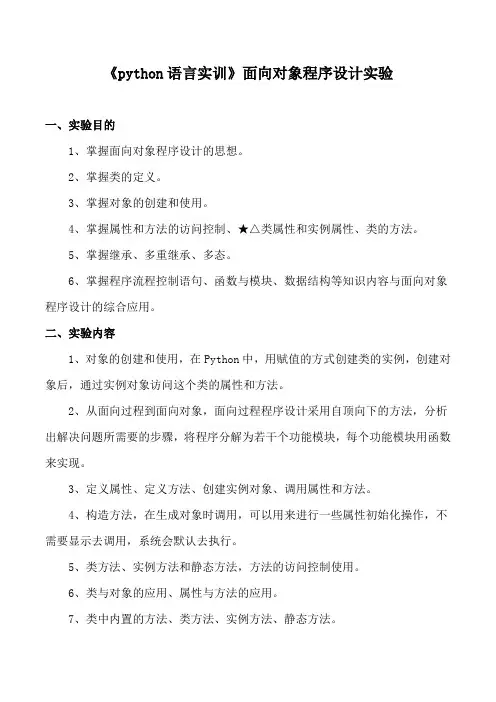
《python语言实训》面向对象程序设计实验一、实验目的1、掌握面向对象程序设计的思想。
2、掌握类的定义。
3、掌握对象的创建和使用。
4、掌握属性和方法的访问控制、★△类属性和实例属性、类的方法。
5、掌握继承、多重继承、多态。
6、掌握程序流程控制语句、函数与模块、数据结构等知识内容与面向对象程序设计的综合应用。
二、实验内容1、对象的创建和使用,在Python中,用赋值的方式创建类的实例,创建对象后,通过实例对象访问这个类的属性和方法。
2、从面向过程到面向对象,面向过程程序设计采用自顶向下的方法,分析出解决问题所需要的步骤,将程序分解为若干个功能模块,每个功能模块用函数来实现。
3、定义属性、定义方法、创建实例对象、调用属性和方法。
4、构造方法,在生成对象时调用,可以用来进行一些属性初始化操作,不需要显示去调用,系统会默认去执行。
5、类方法、实例方法和静态方法,方法的访问控制使用。
6、类与对象的应用、属性与方法的应用。
7、类中内置的方法、类方法、实例方法、静态方法。
8、继承与多态的应用、面向对象程序设计案例的应用。
9、Python程序控制结构、数据结构、函数与模块与面向对象程序设计方法的综合案例。
三、主要实验设备及器材1、计算机终端1套(配备Windous10系统或Windows7系统,英特尔i5及以上的处理器,4G以上内存,256G硬盘)。
2、多媒体教学设备1套。
3、网络设备套件1套。
4、Python软件、PyCharm软件、Anaconda软件等Python软件1套。
四、实验步骤(1)演示性实验教师利用多媒体等设备,对本章节的知识在Python语言的相关软件上进行演练。
(2)验证性实验学生指对Python的语言对象有了一定了解,并提出自己的相关问题,然后学生利用实验室的电脑设备解决问题。
(3)设计性实验设计程序以解决金融工程中的计量分析问题。
2、实验步骤(1)Python的Car对象的创建。
(2)在精灵宝可梦游戏中创建小火龙角色,对给出的各个属性进行迭代和私有化。
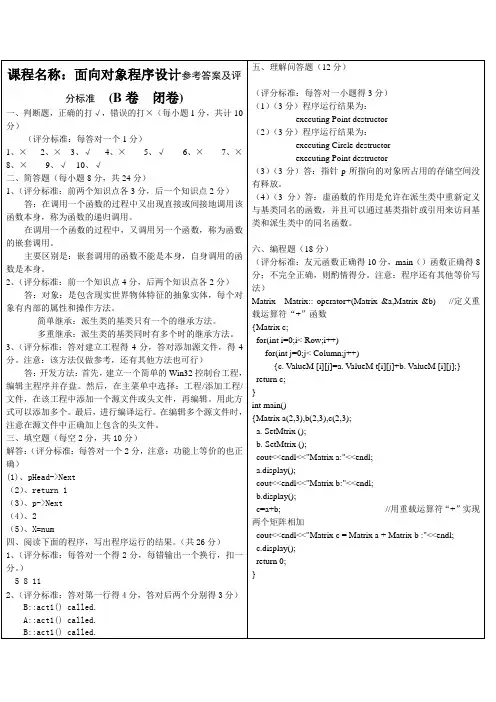

JAVA⾯向对象程序设计(第⼆版)袁绍欣第五章答案1.⾯向对象的主要特征是什么?封装、继承、多态2.封装是如何实现的?封装通过访问控制符实现的,只有通过授权才能访问数据。
3.对象之间如何相互作⽤?作⽤的条件是什么?通过消息,拥有访问类数据成员或成员⽅法的权限。
4.protected修饰符的特点?只有包内其它类、⾃⼰和⼦类可以访问。
5.Object都有哪些⽅法?Object clone() //克隆对象boolean equals() //判断两个引⽤是否指向同⼀个对象void finalize() //释放对象int hashCode() //获得代表对象特有的 hashcode 整数String toString() //代表对象的字符串void notify() //线程同步中唤醒等待线程void wait()//线程同步中线程等待6.重载的⽅法之间⼀般有什么关系?⽅法名相同,⽽参数不同。
返回类型可以相同也可以不同。
7.⼦类覆盖⽗类⽅法需要什么条件?⼦类中定义与⽗类同名的⽅法⼀定是覆盖吗?⽅法名,参数,返回类型全部相同,内容不同。
不⼀定8.封装、继承和多态在⾯向对象设计中的⽤途是什么?封装可以保护类的数据成员,隐藏信息。
⼦类继承⽗类的属性和⽅法后,不⽤重新编写代码,提⾼了代码复⽤性。
多态最重要的是⼦类的功能可以被⽗类的引⽤调⽤,向后兼容。
9.设计Src和Dis两个类,Src中有⼀个被封装的属性,类型类 int ,每当通过特定⽅法更改Src对象中的这个属性后,Dis对象都能得到通知,并向Src发消息获得此属性值。
public class Src{int num;Dis dis;Src(int n){if(n>0)num = n;}void SetDis(Dis d){dis = d;}void Change(int n){if(n>0&&n!=num){num = n;dis.print();}}int getNum(){return num;}public static void main(String[] args) {Src src = new Src(1);Dis dis = new Dis(src);src.SetDis(dis);for(int i=0;i<5;i++){src.Change(i);}}}public class Dis{Src src;Dis(Src s){src = s;}void print(){System.out.println("num被改变为:"+src.getNum()); }}/*结果:num被改变为:2num被改变为:3num被改变为:4*/。
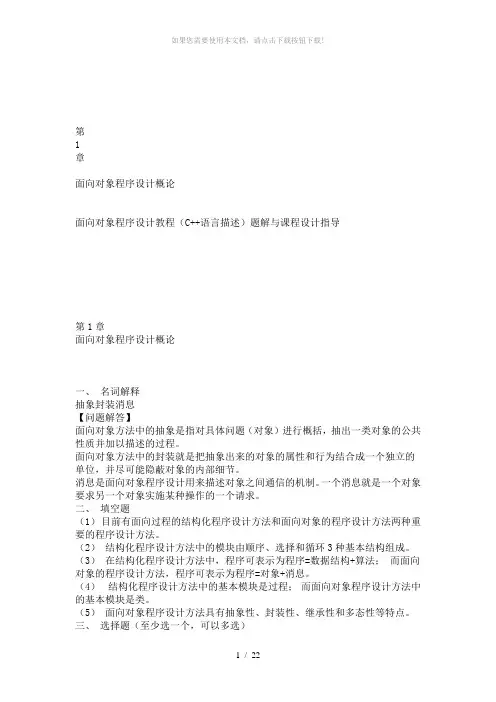
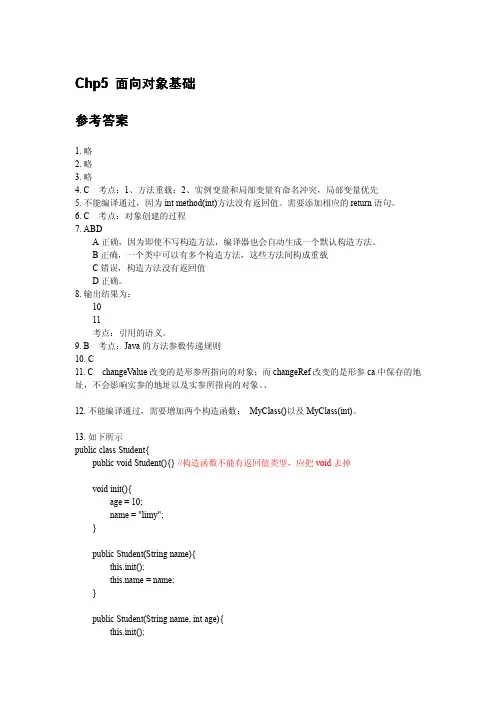
Chp5面向对象基础参考答案1.略2.略3.略4.C考点:1、方法重载;2、实例变量和局部变量有命名冲突,局部变量优先5.不能编译通过,因为int method(int)方法没有返回值。
需要添加相应的return语句。
6.C考点:对象创建的过程7.ABDA正确,因为即使不写构造方法,编译器也会自动生成一个默认构造方法。
B正确,一个类中可以有多个构造方法,这些方法间构成重载C错误,构造方法没有返回值D正确。
8.输出结果为:1011考点:引用的语义。
9.B考点:Java的方法参数传递规则10.C11.C changeValue改变的是形参所指向的对象;而changeRef改变的是形参ca中保存的地址,不会影响实参的地址以及实参所指向的对象。
、12.不能编译通过,需要增加两个构造函数:MyClass()以及MyClass(int)。
13.如下所示public class Student{public void Student(){}//构造函数不能有返回值类型,应把void去掉void init(){age=10;name="limy";}public Student(String name){this.init();=name;}public Student(String name,int age){this.init();this(name);//this()必须放在构造函数中的第一行this.age=age;}int age;String name;}14.见Ex14.java15.应当封装一个Point对象。
具体见Ex15.java16.为Point对象增加一个distance方法,用来计算两点间的距离。
具体见Ex16.java。
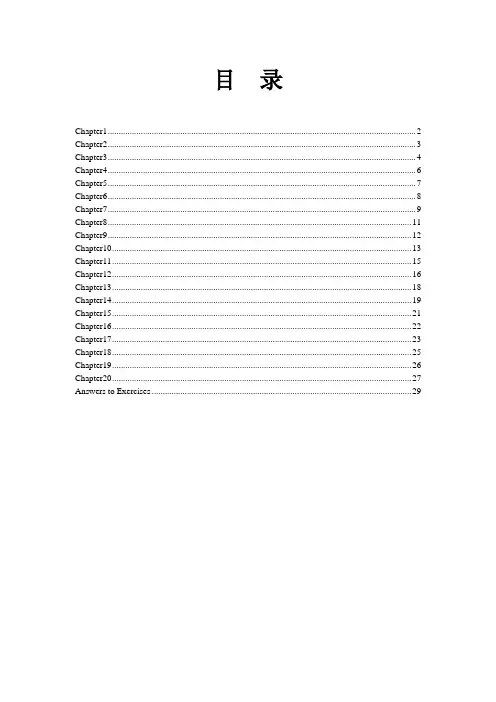
目录Chapter1 (2)Chapter2 (3)Chapter3 (4)Chapter4 (6)Chapter5 (7)Chapter6 (8)Chapter7 (9)Chapter8 (11)Chapter9 (12)Chapter10 (13)Chapter11 (15)Chapter12 (16)Chapter13 (18)Chapter14 (19)Chapter15 (21)Chapter16 (22)Chapter17 (23)Chapter18 (25)Chapter19 (26)Chapter20 (27)Answers to Exercises (29)Chapter1EXERCISESMultiple-choice questions: For each question, choose one of the answers.1. What is software modeling?(a) Developing models of software.(b) Designing software applications before coding.(c) Developing software diagrams.(d) Developing software prototypes.2. What is the Unified Modeling Language?(a) A programming language for describing object-oriented models.(b) A diagramming tool for drawing object-oriented models.(c) A graphical language for describing object-oriented models.(d) A standardized graphical language and notation for describing object-oriented models.3. What is a software architecture?(a) The software inside a building.(b) The structure of a client/server system.(c) The overall structure of a software system.(d) The software classes and their relationships.4. What is a software design notation?(a) Notes about the software design.(b) A graphical or textual description of the software.(c) Documentation of the software.(d) A systematic approach for producing a design.5. What is a software design concept?(a) A graphical or textual description of the software.(b) Documentation of the software.(c) A fundamental idea that can be applied to designing a system.(d) A systematic approach for producing a design.6. What is a software design strategy?(a) A graphical or textual description of the software.(b) A fundamental idea that can be applied to designing a system.(c) A systematic approach for producing a design.(d) An overall plan and direction for developing a design.7. What are software structuring criteria?(a) Fundamental ideas that can be applied to designing a system.(b) Systematic approaches for producing a design.(c) Guidelines used to help in structuring a software system into its components.(d) Overall plans for developing a design.8. What is a software design method?(a) A systematic approach for producing a design.(b) Guidelines used to help in structuring a software system into its components.(c) An overall plan for developing a design.(d) A graphical or textual description of the software.9. What is a platform-independent model (PIM)?(a) A software platform before a commitment is made to a specific hardware platform.(b) A precise model of the software architecture before a commitment is made to a specific platform.(c) A precise model of the software architecture mapped to a specific platform.(d) A graphical or textual description of the software.10. What is a platform-specific model (PSM)?(a) A specific hardware platform.(b) A precise model of the software architecture before a commitment is made to a specific platform.(c) A precise model of the software architecture mapped to a specific platform.(d) A graphical or textual description of the software.Chapter2EXERCISESMultiple-choice questions: For each question, choose one of the answers.1. How is an actor depicted on a use case diagram?(a) An oval(b) A stick figure(c) A box(d) A dashed line2. How is a use case depicted on a use case diagram?(a) An oval(b) A stick figure(c) A box(d) A dashed line3. How is a class depicted on a class diagram?(a) A box with one compartment(b) A box with one or two compartments(c) A box with one, two, or three compartments(d) An oval4. How is an association depicted on a class diagram?(a) A solid line joining two class boxes(b) A dashed line joining two class boxes(c) A diamond touching the upper class box(d) An arrowhead touching the upper class box5. How is public visibility depicted for a class element on a class diagram?(a) + sign(b) −sign(c) # sign(d) ∗sign6. What are the two kinds of UML interaction diagrams?(a) Class diagram and sequence diagram(b) Sequence diagram and communication diagram(c) Class diagram and communication diagram(d) Statechart and communication diagram7. What does an interaction diagram depict?(a) Objects and links(b) Classes and relationships(c) Objects and messages(d) States and events8. What does a statechart diagram depict?(a) Objects and links(b) Classes and relationships(c) Objects and messages(d) States and events9. What is a UML package?(a) A box(b) A grouping of classes(c) A grouping of use cases(d) A grouping of model elements10. What does a deployment diagram depict?(a) The physical configuration of the system in terms of physical classes and physical connections between the classes(b) The physical configuration of the system in terms of physical objects and physical connections between the objects(c) The physical configuration of the system in terms of physical nodes and physical connections between the nodes(d) The physical configuration of the system in terms of physical computers and physical networks between the computersChapter3EXERCISESMultiple-choice questions: For each question, choose one of the answers.1. What is a software life cycle?(a) The life of the software(b) A cyclic approach to developing software(c) A phased approach to developing software(d) The life of software developed in cycles2. What is the waterfall life cycle model?(a) Software developed under a waterfall(b) A process model in which each phase is completed before the next phase is started(c) A process model in which phases are overlapped(d) A process model in which phases are cyclic3. Which of the following is a limitation of the waterfall life cycle model?(a) Software is developed in phases.(b) Each phase is completed before the next phase is started.(c) Software development is cyclic.(d) Software requirements are not properly tested until a working system is available.4. Which of the following approaches can overcome the limitation in the previous question?(a) Phased software development(b) Throwaway prototyping(c) Evolutionary prototyping(d) Incremental development5. What is evolutionary prototyping?(a) Phased software development(b) Throwaway prototyping(c) Risk-driven development(d) Incremental development6. What approach does the spiral model emphasize?(a) Phased software development(b) Throwaway prototyping(c) Risk-driven development(d) Incremental development7. What is the goal of software validation?(a) Building the system(b) Building the right system(c) Building the system right(d) Testing the system8. What is the goal of software verification?(a) Building the system(b) Building the right system(c) Building the system right(d) Testing the system9. What is “white box”testing?(a) Unit testing(b) Integration testing(c) Testing with knowledge of the system internals(d) Testing without knowledge of the software internals10. What is “black box”testing?(a) System testing(b) Integration testing(c) Testing with knowledge of the system internals(d) Testing without knowledge of the software internalsChapter4EXERCISESMultiple-choice questions: For each question, choose one of the answers.1. Which of the following are object-oriented concepts?(a) Modules and interfaces(b) Modules and information hiding(c) Classes, information hiding, and inheritance(d) Concurrency and information hiding2. Which of the following is a characteristic of an object?(a) A function or subroutine(b) A module(c) Groups data and procedures that operate on the data(d) Groups a function and an algorithm3. What is a class?(a) An object instance(b) The implementation of the object(c) A collection of objects with the same characteristics(d) A collection of objects with different characteristics4. What is an operation (also known as method) of a class?(a) Specification and the implementation of a function performed by a class(b) Specification and the implementation of a subroutine provided by a class(c) Specification and the implementation of a function or procedure provided by a class(d) Specification and the implementation of an interface provided by a class5. What is the signature of an operation?(a) The operation’s name(b) The operation’s function or subroutine(c) The operation’s name, parameters, and return value(d) The object’s interface6. What is the interface of a class?(a) The signature of a class(b) The specification of operations provided by the class(c) The internals of the class(d) The implementation of the class7. What is an attribute?(a) A description of a class(b) An internal property of a class(c) A data item held by a class(d) A parameter of a class8. What is information hiding in software design?(a) Hiding information so that it cannot be found(b) Hiding a design decision that is considered likely to change(c) Hiding information to make it secure(d) Encapsulating data in a class9. What is data abstraction?(a) Another name for information hiding(b) Encapsulating data so that its structure is hidden(c) Storing data in a database(d) Storing data in a data structure10. What is inheritance?(a) A mechanism for inheriting characteristics from a parent(b) A mechanism for sharing and reusing code between classes(c) A mechanism for sharing data between classes(d) A mechanism for hiding information between classesChapter5EXERCISESThe following questions relate to the software modeling and design method (COMET) described in this book.Multiple-choice questions: For each question, choose one of the answers.1. What is carried out during requirements modeling?(a) Functional requirements of the system are described in terms of functions, inputs, and outputs.(b) Functional requirements of the system are described in terms of actors and use cases.(c) Functional requirements of the system are described textually.(d) Functional requirements of the system are determined by interviewing users.2. What is carried out during analysis modeling?(a) Developing use case models(b) Developing data flow and entity relationship diagrams(c) Developing static and dynamic models(d) Developing software architectures3. What is carried out during design modeling?(a) Developing use case models(b) Developing data flow and entity relationship diagrams(c) Developing static and dynamic models(d) Developing software architectures4. What is carried out during incremental software construction?(a) Detailed design and coding of the classes in a subset of the system(b) Detailed design, coding, and unit testing of the classes in a subset of the system(c) Coding and unit testing of the classes in a subset of the system(d) Unit and integration testing of the classes in a subset of the system5. What is carried out during incremental software integration?(a) Implementation of the classes in each software increment(b) Unit testing of the classes in each software increment(c) Integration testing of the classes in each software increment(d) System testing of the classes in each software increment6. What is carried out during system testing?(a) White box testing(b) Black box testing(c) Unit testing(d) Integration testingChapter6EXERCISESMultiple-choice questions: For each question, choose one of the answers.1. What is a use case?(a) A case study involving users(b) A sequence of interactions between the user and the system(c) A sequence of interactions between the user and the objects in the system(d) A sequence of user inputs to the system2. What is an actor in a use case?(a) An object inside the system(b) A person who performs on stage(c) An external entity that interacts with the system(d) The customer to whom the system will be delivered3. What is a primary actor?(a) The actor who goes on stage first(b) The actor that starts the use case(c) An actor that participates in the use case(d) An object inside the system4. What is a secondary actor?(a) The actor who goes on stage second(b) The actor that starts the use case(c) An actor that participates in the use case(d) An object inside the system5. What is an alternative sequence in a use case?(a) A sequence that describes an error case(b) A sequence that is different from the main sequence(c) A sequence that describes interactions with a secondary actor(d) A sequence that describes interactions with a primary actor6. What can an inclusion use case be used for?(a) To describe an inclusive use case(b) To describe a lengthy interaction with an actor(c) To describe functionality that is common to more than one use case(d) To describe a use case that includes other use cases7. What can an extension use case be used for?(a) To describe a lengthy interaction with an actor(b) To describe functionality that is common to more than one use case(c) To describe the functionality of a use case that is extended by another use case(s)(d) To describe a conditional part of a different use case that is only executed under certain circumstances8. What can an activity diagram be used for in use case modeling?(a) To depict the sequence of activities executed by all the use cases in the System(b) To depict the sequence of external activities that the use case interacts with(c) To depict the sequence of active objects in a use case(d) To depict the activities in the main and alternative sequences of a use case9. How can a nonfunctional requirement be described in a use case model?(a) In a separate section of the use case description(b) As a use case precondition(c) As a use case postcondition(d) In a separate document10. What is a use case package?(a) A package describing the actors in the system(b) A package describing the use cases in the system(c) A group of related use cases(d) The package of objects that participate in the use caseChapter7EXERCISESMultiple-choice questions: For each question, choose one of the answers.1. What is a class?(a) A course(b) An object instance(c) A client or server in the system(d) A collection of objects with the same characteristics2. What is an attribute?(a) A relationship between two classes(b) A parameter of an operation or method(c) A data value held by an object in a class(d) The return value from an operation3. What is an association?(a) A relationship between two classes(b) A relationship between two objects(c) A link between two classes(d) A link between two objects4. What is meant by the multiplicity of an association?(a) The number of associations in a class(b) The number of associations between two classes(c) How many instances of one class relate to how many instances of another class(d) How many instances of one class relate to a single instance of another class.5. What is an association class?(a) A class with multiple associations(b) A class with one association(c) A class that models an association between two or more classes(d) A class that models an association between two or more objects6. What is a generalization/specialization hierarchy?(a) A whole/part relationship(b) An inheritance relationship(c) An association between a generalized class and a specialized class(d) A layered hierarchy7. What is a composition hierarchy?(a) A weak form of a generalization/specialization hierarchy(b) A strong form of a generalization/specialization hierarchy(c) A weak form of a whole/part relationship(d) A strong form of a whole/part relationship8. What is an aggregation hierarchy?(a) A weak form of a generalization/specialization hierarchy(b) A strong form of a generalization/specialization hierarchy(c) A weak form of a whole/part relationship(d) A strong form of a whole/part relationship9. What does the system context class diagram define?(a) The entity classes in the system(b) How the system interfaces to other systems(c) The boundary between the system and the external environment(d) The context classes in the system10. What is an entity class?(a) A class on an entity/relationship diagram(b) A class that stores data(c) A class that interfaces to an external entity(d) An external classChapter8EXERCISESMultiple-choice questions: For each question, choose one of the answers.1. What is a boundary object?(a) An external object(b) An object that stores data(c) An object that communicates with an external object(d) An object that controls other objects2.What is a control object?(a) An object that depends on other objects(b) An object that communicates with an external object(c) An object that controls other objects(d) An object that is controlled by other objects3. What is a state-dependent control object?(a) An object that depends on a state machine(b) An object that communicates with a state machine(c) An object that controls a state machine(d) An object that executes a state machine4. What is a coordinator object?(a) A manager object(b) An object that makes decisions based on a state machine(c) A decision-making object(d) An object that decides which entity object to interact with5. How would you determine a boundary class from the context diagram?(a) By looking at it(b) By selecting the external classes on the context diagram(c) By determining the software classes that communicate with the external classes(d) By drawing the boundary between the hardware and software classes6. What is a timer object?(a) An external clock(b) An internal clock(c) An object that is awakened by an external timer(d) An object that interacts with a clock7. What do class structuring criteria help with?(a) Structuring an application into classes(b) Defining the attributes of a class(c) Defining the associations of a class(d) Defining the operations of a class8. What is the classification process for application classes analogous to?(a) Categorizing books in a library(b) Deciding how many copies of a book are needed(c) Finding the classrooms in a school(d) Identifying what labs the school has9. What is the purpose of a stereotype in class structuring?(a) To label a class according to its class structuring criterion(b) To identify the objects that belong to the same class(c) To distinguish between external objects and software objects(d) To identify the association between two classes10. What is a business logic object?(a) An object used in business applications(b) An object that defines business-specific application logic(c) The internal logic of an object(d) A business object that determines whether a client request is logical Chapter9EXERCISESMultiple-choice questions: For each question, choose one of the answers.1. What does an interaction diagram depict?(a) The state and transitions inside a control object(b) Classes and their relationships(c) Software objects and the sequence of their interactions(d) The external objects communicating with the system2. How is an actor depicted on an interaction diagram?(a) An actor has an association with the interaction diagram.(b) An actor can provide input to or receive output from a boundary object.(c) An actor can provide input to or receive output from a boundary class.(d) An instance of an actor can provide input to or receive output from a boundary object.3. What does a sequence diagram depict?(a) The sequence of external objects communicating with each other(b) Classes and their relationships(c) Software objects and the sequence of their interactions(d) The external objects communicating with the system4. What does a communication diagram depict?(a) The sequence of external objects communicating with each other(b) Classes and their relationships(c) Software objects and the sequence of their interactions(d) The external objects communicating with the system5. What is the instance form of an interaction diagram?(a) Depicts several object instances interacting with each other(b) Depicts one possible sequence of interactions among object instances(c) Depicts all possible interactions among object instances(d) Depicts all object instances and their links to each other6. What is the generic form of an interaction diagram?(a) Depicts several objects interacting with each other(b) Depicts one possible sequence of interactions among objects(c) Depicts all possible interactions among objects(d) Depicts all classes and their associations with each other7. During dynamic interaction modeling, use cases are realized as follows:(a) Determine objects that participate in each use case and the sequence of interactions among them.(b) Determine external objects and the sequence in which they provide inputs to and receive outputs from each use case.(c) Determine sequence of interactions among use cases.(d) Determine how a use case is depicted through internal states and transitions between them.8. Which of the following interactions could happen on an interaction diagram?(a) An external user sends a message to a user interaction object.(b) An external user sends a message to an entity object.(c) An external user sends a message to an I/O object.(d) An external user sends a message to a printer object.9. Which of the following interactions is NOT likely to happen on an interaction diagram?(a) A user interaction object sends a message to an entity object.(b) An input object sends a message to a state-dependent control object.(c) An input object sends a message to a printer object.(d) A user interaction object sends a message to a proxy object.10. What kind of object would be the first object to receive an input from an external object?(a) A user interaction object(b) A proxy object(c) An entity object(d) A boundary objectChapter10EXERCISESMultiple-choice questions: For each question, choose one of the answers.1. What is a state in a state machine?(a) A recognizable situation that exists over an interval of time(b) A condition that is True or False(c) An input from the external environment(d) An output from the system2. What is an event in a state machine?(a) A discrete signal that causes a change of state(b) An input from the external environment(c) An input that is True or False(d) The result of a state transition3. What is an action in a state machine?(a) An occurrence at a point in time(b) A cause of a state transition(c) An interval between two successive events(d) A computation that executes as a result of a state transition4. What is an entry action in a state machine?(a) An action that is performed when the state is entered(b) An action that is performed when the state is left(c) An action that starts executing when the state is entered and completes executing when the state is left(d) An action that executes as a result of a state transition5. What is an exit action in a state machine?(a) An action that is performed when the state is entered(b) An action that is performed when the state is left(c) An action that starts executing when the state is entered and completes executing when the state is left(d) An action that executes as a result of a state transition6. What is a condition used for in a state machine?(a) A conditional action(b) A conditional state(c) A conditional state transition(d) A conditional event7. What is a state transition into a composite state equivalent to?(a) A transition into only one of the substates(b) A transition into each of the substates(c) A transition into none of the substates(d) A transition into any one of the substates8. What is a state transition out of a composite state equivalent to?(a) A transition out of only one of the substates(b) A transition out of each of the substates(c) A transition out of none of the substates(d) A transition out of any one of the substates9. How does a composite state relate to a substate?(a) A composite state is decomposed into substates.(b) Composite states are composed into substates.(c) A composite state transitions to a substate.(d) A substate transitions to a composite state.10. If two actions are shown on a given state transition, which of the following is true?(a) The two actions are dependent on each other.(b) The two actions are independent of each other.(c) One action provides an input to the other action.(d) The second action executes when the first action completes execution.Chapter11EXERCISESMultiple-choice questions: For each question, choose one of the answers.1. What does a state-dependent interaction involve?(a) A control object(b) A state-dependent entity object(c) A state-dependent control object(d) A state-dependent user interaction object2. Which kind of object executes a state machine(a) Any software object(b) An entity object(c) A state-dependent control object(d) A statechart3. An input message to a state-dependent control object corresponds to:(a) An event on the internal state machine(b) An action on the internal state machine(c) A condition on the internal state machine(d) A state on the internal state machine4. An output message from a state-dependent control object corresponds to:(a) An event on the internal state machine(b) An action on the internal state machine(c) A condition on the internal state machine(d) A state on the internal state machine5. An interaction diagram should be developed for:(a) Only the main sequence of the use case(b) The main sequence and every alternative sequence of the use case(c) The main sequence and a representative alternative sequence of the use case(d) The alternative sequences of the use case6. Which of the following could happen on an interaction diagram?(a) A state-dependent control object sends a message to an entity object.(b) A state-dependent control object sends a message to a coordinator object.(c) A state-dependent control object sends a message to a printer object.(d) All of the above7. If the same state machine is used in more than one use case, how is this modeled on interaction diagrams?(a) Develop one state-dependent control object for each use case.(b) Develop one state-dependent control object containing states from each use case.(c) Develop a hierarchical state machine.(d) Develop a coordinator object.8. How would two state-dependent control objects communicate with each other?(a) By sending messages to each other(b) By transitioning to the same state(c) Through an entity object(d) Through a proxy object9. An object can send alternative messages a or b to a state-dependent control object. How is this handled in the state machine?(a) One state with a different transition out of it for each incoming message(b) One state for each of the alternative messages(c) A composite state to handle the alternative messages(d) A substate for each alternative Message10. In a system in which a client object executes a state machine and communicates with a service, which of the following is true?(a) The client has a state-dependent control object but the service does not.(b) The service has a state-dependent control object but the client does not.(c) Both the client and the service have state-dependent control objects.(d) Neither the client nor the service has a state-dependent control object.Chapter12EXERCISESMultiple-choice questions: For each question, choose one of the answers.1. What does the software architecture describe?(a) The software inside a building(b) The structure of a client/server system(c) The overall structure of a software system(d) The software classes and their relationships2. Which of the following statements is NOT true for a component?(a) A composite object composed of other objects(b) An operation(c) A simple object(d) Provides an interface3. What is a structural view of a software architecture?(a) A view in terms of a module hierarchy(b) A view in terms of components and connectors(c) A view of the physical configuration in terms of nodes and interconnections(d) A view in terms of objects and messages。
实验一熟悉VC++IDE开发环境一、实验目的1、熟悉VC++6.0集成开发环境,熟练掌握VC++6.0项目工作区、各种编辑器、菜单栏和工具栏的使用。
2、掌握如何编辑、编译、连接和运行一个C++程序。
3、通过运行简单的C++程序,初步了解C++源程序的结构和特点。
二、实验要求1、分析下列程序运行的结果。
程序一:#include <iostream.h>int add(int x,int y=8);void main(){ int x=4;cout<<add(x)<<",";cout<<add(x,add(add(x,add(x))))<<endl;}int add(int x,int y){ return x+y;}//12,28程序二:#include <iostream.h>void main(){ int *p,i;i=5;p=&i;i=*p+10;cout<<"i="<<i<<endl;}//i=15程序三:#include <iostream.h>void main(void){ int i=10;int &r=i;r++;cout<<"i="<<i<<", r="<<r<<'\n';i=88;cout<<"i="<<i<<", r="<<r<<'\n';}//i=11,r=11i=88,r=88程序四:#include <iostream.h>int f(int i){ static int k=1;for(;i>0;i--)k +=i;return k;}void main(){ int i;for(i=0;i<5;i++)cout<<f(i)<<" ";}// 1 2 5 11 21程序五:#include <iostream.h>void func();int n=1;void main(){static int a;int b= -9;cout <<"a:"<<a<<"b:"<<b<<"n:" <<n<<endl;b+=4;func();cout <<"a:"<<a<<"b:"<<b<<"n:"<<n<<endl;n+=10;func();}void func(){ static int a=2; int b=5;a+=2;n+=12;b+=5;cout <<"a:" <<a<<"b:" <<b<<"n:" <<n <<endl;}// a:0 b:-9 n:1a:4 b:10 n:13a:0 b:-5 n:13a:6 b:10 n:35实验二C++对C的扩充一、实验目的1、了解在面向对象程序设计过程中C++对C功能的扩充与增强,并善于在编写程序的过程中应用这些新功能。
5.7 习题1. 选择题1)下列不属于面向对象编程的3个特征的是(B)A.封装B. 指针操作C. 多态D. 继承2)下列关于继承性的描述中,错误的是(C)A.一个类可以同时生成多个子类B.子类继承父类除了private修饰之外的所有成员C.Java语言支持单重继承和多重继承D.Java语言通过接口实现多重继承3)下列对于多态的描述中,错误的是(A)A.Java语言允许运算符重载B.Java语言允许方法符重载C.Java语言允许成员变量覆盖D.多态性提高了程序的抽象性和简洁性4)关键字super的作用是(D)A.用来访问父类被隐藏的成员变量B.用来调用父类中被重载的方法C.用来调用父类的构造方法D.以上都是5)下面程序定义了一个类,关于该类,说法正确的是(D)abstract class Aa{…}A.该类能调用Aa()构造方法实例化一个对象B.该类不能被继承C.该类的方法都不能被重载D.以上说法都不对6)下列关于接口的描述中,错误的是(D)A.接口实际上是由常量和抽象方法构成的特殊类B.一个类只允许继承一个接口C.定义接口使用的关键字是interfaceD.在继承接口的类中通常要给出接口中定义的抽象方法的具体实现7)下面关于包的描述中,错误的是(A)A.包是若干对象的集合B. 使用package语句创建包C. 使用import语句引入包D. 包分为有名包和无名包两种8)如果java.abc.def中包含xyz类,则该类可记作(C)A. java.xyzB. java.abc.xyzC. java.abc.def.xyzD. java.xyz.abc9)下列方法中,与方法public void add(int a){}为不合理的重载方法的是( B)A. public void add(char a)B. public int add(int a)C. public void add(int a, int b)D. public void add(float a)10)设有如下类的定义:public class parent{int change( ) {}}Class Child extends Parent{ }则下面的方法可加入Child类中的是(A)A. public int change( ){ }B. final int change(int i){ }C. private int change( ){ }D. abstract int change( ){ }2.填空题(1) 在Java程序中,把关键字(super)加到方法名称的前面,可实现子类调用父类的方法。